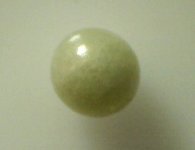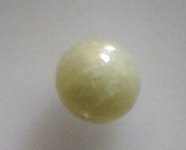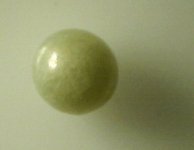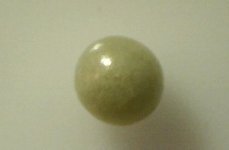Lagoon Island Pearls
Well-known member
- Joined
- Dec 8, 2009
- Messages
- 2,143
Two days ago, I found a very rare natural pearl from a Rock Oyster (Pododesmus macroschrisma) Although this species is common in British Columbia, this is the first time a nearly round pearl has been identified.
Commonly known as "Jingle Shells", rock oysters are quite edible and the right valves (hidden bottom shell) are often used in beachcomber mobiles and wind chimes. They are highly nacreous and nearly transparent.
Phylum Mollusca
Class Bivalvia
Subclass Pteriomorphia
Order Ostreoida
Suborder Pectinina
Family Anomiidae
Description: This unique bivalve species has thin valves, nearly circular in outline. The right valve is permanently cemented to the substrate (rock, wood, abalone shells, or plastic). The right valve has a large hole in it near the hinge, through which byssal material cements the bivalve to the rock (photo). The left valve has a dark muscle scar opposite the perforation in the right shell, and is otherwise polished inside and often bright iridescent green. Flesh is bright orange. Diameter to 10 cm.
Geographical Range: Bering Sea, Alaska to Baja California; Chukchi Sea
Depth Range: Low intertidal to 90 m
Habitat: Cemented to rocks, plastic, or wood. Common on pilings
What is scientifically significant about this find? It was often thought the green tint inside the shells of this bivalve was factored by external algae growth which was cemented in place by the processes which grow shell. This pearl proves otherwise, afterall it was formed in the gonad of the animal in complete absence of it's normal extrapallial mantle functions.
It bears remarkable similarity in extracrystalline structure to scallop pearls and stands to reason as it's of the subclass pectinina. The only difference is color, markedly different from other scallop pearls, which are almost always typically off-white or brown across the species.
Another important factor is age. These grow rapidly and don't live long. (probably no more than four years). Most will be taken by sea stars before maturity, hence the likelyhood of a pearl developing at an identifiable level is remote at best.




Commonly known as "Jingle Shells", rock oysters are quite edible and the right valves (hidden bottom shell) are often used in beachcomber mobiles and wind chimes. They are highly nacreous and nearly transparent.
Phylum Mollusca
Class Bivalvia
Subclass Pteriomorphia
Order Ostreoida
Suborder Pectinina
Family Anomiidae
Description: This unique bivalve species has thin valves, nearly circular in outline. The right valve is permanently cemented to the substrate (rock, wood, abalone shells, or plastic). The right valve has a large hole in it near the hinge, through which byssal material cements the bivalve to the rock (photo). The left valve has a dark muscle scar opposite the perforation in the right shell, and is otherwise polished inside and often bright iridescent green. Flesh is bright orange. Diameter to 10 cm.
Geographical Range: Bering Sea, Alaska to Baja California; Chukchi Sea
Depth Range: Low intertidal to 90 m
Habitat: Cemented to rocks, plastic, or wood. Common on pilings
What is scientifically significant about this find? It was often thought the green tint inside the shells of this bivalve was factored by external algae growth which was cemented in place by the processes which grow shell. This pearl proves otherwise, afterall it was formed in the gonad of the animal in complete absence of it's normal extrapallial mantle functions.
It bears remarkable similarity in extracrystalline structure to scallop pearls and stands to reason as it's of the subclass pectinina. The only difference is color, markedly different from other scallop pearls, which are almost always typically off-white or brown across the species.
Another important factor is age. These grow rapidly and don't live long. (probably no more than four years). Most will be taken by sea stars before maturity, hence the likelyhood of a pearl developing at an identifiable level is remote at best.




